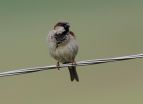What is a species? It could be difficult to reply if you work with aphids
2014-11-03
(Press-News.org) Karyotype is usually a stable feature of each species since chromosomal changes, if they occur, may contribute to the formation of barriers between populations causing the establishment of reproductive isolation and speciation as possible consequences. Indeed, mating between individuals with different karyotypes frequently produces hybrids with a reduced fertility (or sterile) due to mis-segregation of chromosomes during meiosis.
Despite the occurrence of this general rule, it seems that some animal species failed their examination in genetics and adopt different rules. Recent data published in the international journal Comparative Cytogenetics by Mauro Mandrioli, Federica Zanasi and Gian Carlo Manicardi of the University of Modena and Reggio Emilia (Italy) clearly showed that populations of the green peach aphid Myzus persicae (one of the most dangerous pest crop insects in the world) may have unusual karyotypes due to chromosomal fragmentations and/or rearrangements also within the same individual.
Interestingly, the observed chromosomal rearrangements involve more frequently the same chromosomes thus suggesting that the chromosomal architecture can make some rearrangements less random than others and some chromosomes more prone to change their structure than other ones.
As the authors also observed in previous works, some aphids showed different chromosome numbers also comparing cells belonging to a same individual "forgetting" that chromosome instability within individuals should be typical of malignant cells and not of healthy insects showing a high reproductive rate. This aphid species seems to be therefore the sum of populations possessing different karyotypes that in turn can give diverse genetic/ecological/evolutionary responses in relation to imposed selective environmental forces.
The evolutionary history of M. persicae is marked with speciation events and the tobacco specialist subspecies M. persicae nicotianae, known as the tobacco aphid, is an example. It is therefore intriguing that this species preserved its morphological identity through time and across a wide geographical scale despite the presence of several populations with unusual karyotypes.
INFORMATION:
Original Source
Mandrioli M, Zanasi F, Manicardi G (2014) Karyotype rearrangements and telomere analysis in Myzus persicae (Hemiptera, Aphididae) strains collected on Lavandula sp. plants. Comparative Cytogenetics 8(4): 259-274. doi: 10.3897/CompCytogen.v8i4.8568
[Attachments] See images for this press release:

ELSE PRESS RELEASES FROM THIS DATE:
2014-11-03
MADISON, Wis. – Scientists today disclosed a new method to convert lignin, a biomass waste product, into simple chemicals. The innovation is an important step toward replacing petroleum-based fuels and chemicals with biorenewable materials, says Shannon Stahl, an expert in "green chemistry" at the University of Wisconsin-Madison.
Lignin is the substance that makes trees and cornstalks sturdy, and it accounts for nearly 30 percent of the organic carbon in the biosphere. Stahl, senior author of a new report in the journal Nature, notes that lignin is a waste product ...
2014-11-03
Scientists at the European Molecular Biology Laboratory (EMBL) in Heidelberg, Germany and collaborators from Heidelberg University, in the joint Molecular Medicine Partnership Unit, have obtained the first structure of the immature form of HIV at a high enough resolution to pinpoint exactly where each building block sits in the virus. The study, published online today in Nature, reveals that the building blocks of the immature form of HIV are arranged in a surprising way.
"The structure is definitely different from what we'd expected," says John Briggs from EMBL, who led ...
2014-11-03
A new policy paper led by University of York scientists, in partnership with Proforest, aims to increase awareness among researchers of the High Conservation Value (HCV) approach to safeguarding ecosystems and species.
The HCV approach is widely used in sustainable land management schemes to identify important ecosystems and species to conserve, but is little known in academia and the scientific evidence base is lacking.
The policy paper encourages new research into the effectiveness of the HCV process and greater knowledge exchange between scientists, HCV users and ...
2014-11-03
If chronic lymphocytic leukemia patients with a good or poor prognosis could be identified already at the time of diagnosis, physicians would have better possibilities to adjust their therapeutic and follow-up strategies. Now researchers at Uppsala University, together with international colleagues, have discovered a new correlation between specific molecular features of the disease and subgroups of patients with different prognosis.
The results have been published in the journal Lancet Haematology.
Chronic lymphocytic leukemia (CLL) is an incurable tumour disease ...
2014-11-03
Some MRSA bugs in UK hospitals can be traced back to a type of bacteria found in farm animals, a study suggests.
A strain of drug-resistant bacteria carried by some livestock – the MRSA strain Staphylococcus aureus CC398 – has also been found in patients, researchers say.
People and animals generally harbour distinct variants of CC398, which the team say evolved from the same original bacteria. However, the CC398 strain found in livestock can be transmitted to humans, and the study shows that this has happened on many occasions.
The study provides new ...
2014-11-03
Using the Very Large Telescope Interferometer (VLTI) in near-infrared light [1], the team of astronomers observed 92 nearby stars to probe exozodiacal light from hot dust close to their habitable zones and combined the new data with earlier observations [2]. Bright exozodiacal light, created by the glowing grains of hot exozodiacal dust, or the reflection of starlight off these grains, was observed around nine of the targeted stars.
From dark clear sites on Earth, zodiacal light looks like a faint diffuse white glow seen in the night sky after the end of twilight, or ...
2014-11-03
Researchers from Australia report that low birth weight and preterm birth are linked to increased risk for osteoarthritis (OA)-related hip replacements in adulthood. Findings published in the American College of Rheumatology (ACR) journal, Arthritis Care & Research, indicate that low birth weight and pre-term babies were not at greater risk of knee arthroplasty due to OA as adults.
According to the ACR, 27 million Americans over the age of 25 are diagnosed with clinical OA. Symptoms of OA range from mild to severe and include pain, stiffness, and swelling of joints. ...
2014-11-03
WHITE PLAINS, N.Y., Nov. 3, 2014 – The March of Dimes is calling for a nationwide effort to reduce U.S. preterm births to 5.5 percent of all live births by 2030. Seven other developed countries already have preterm birth rates below 6 percent, and 15 have rates below 7 percent.
The U.S. rate of 11.4 percent in 2013 is one of the highest. The U.S. ranked 37th out of 39 high resource countries in 2010.
"The United States spends more money per capita on health care than almost any other country in the world, and yet our premature birth rate and our infant mortality ...
2014-11-03
Bird populations across Europe have experienced sharp declines over the past 30 years, with the majority of losses from the most common species, say the University of Exeter, the RSPB and the Pan-European Common Bird Monitoring Scheme (PECBMS) in a new study. However numbers of some less common birds have risen.
The study, published today in the journal Ecology Letters, reveals a decrease of 421 million individual birds over 30 years. Around 90 percent of these losses were from the 36 most common and widespread species, including house sparrows, skylarks, grey partridges ...
2014-11-03
THE cancer drug eribulin, originally developed from sea sponges, could give women with advanced triple negative breast cancer an average of five extra months of life, according to research presented at the National Cancer Research Institute (NCRI) Cancer Conference in Liverpool today (Monday).
Researchers led by Professor Chris Twelves, based at the University of Leeds and Leeds Teaching Hospitals NHS Trust, looked at two major clinical trials of more than 1,800 women with breast cancer that had started to spread to other parts of the body. The phase III trials – ...
LAST 30 PRESS RELEASES:
[Press-News.org] What is a species? It could be difficult to reply if you work with aphids



